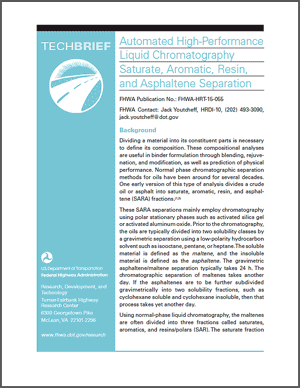U.S. Department of Transportation
Federal Highway Administration
1200 New Jersey Avenue, SE
Washington, DC 20590
202-366-4000
Federal Highway Administration Research and Technology
Coordinating, Developing, and Delivering Highway Transportation Innovations
| TECHBRIEF |
| This techbrief is an archived publication and may contain dated technical, contact, and link information |
| Publication Number: FHWA-HRT-15-055 Date: October 2016 |
Publication Number: FHWA-HRT-15-055 Date: October 2016 |
PDF Version (812 KB)
PDF files can be viewed with the Acrobat® Reader®
| FHWA Publication No.: FHWA-HRT-15-055 FHWA Contact: Jack Youtcheff, HRDI-10, (202) 493-3090, jack.youtcheff@dot.gov |
Dividing a material into its constituent parts is necessary to define its composition. These compositional analyses are useful in binder formulation through blending, rejuvenation, and modification, as well as prediction of physical performance. Normal phase chromatographic separation methods for oils have been around for several decades. One early version of this type of analysis divides a crude oil or asphalt into saturate, aromatic, resin, and asphaltene (SARA) fractions.(1,2)
These SARA separations mainly employ chromatography using polar stationary phases such as activated silica gel or activated aluminum oxide. Prior to the chromatography, the oils are typically divided into two solubility classes by a gravimetric separation using a low-polarity hydrocarbon solvent such as isooctane, pentane, or heptane. The soluble material is defined as the maltene, and the insoluble material is defined as the asphaltene. The gravimetric asphaltene/maltene separation typically takes 24 h. The chromatographic separation of maltenes takes another day. If the asphaltenes are to be further subdivided gravimetrically into two solubility fractions, such as cyclohexane soluble and cyclohexane insoluble, then that process takes yet another day.
Using normal-phase liquid chromatography, the maltenes are often divided into three fractions called saturates, aromatics, and resins/polars (SAR). The saturate fraction consists of both linear and branched fully saturated organic molecules of low polarity containing carbon and hydrogen with essentially no hetero-atoms. A molecule in the aromatics fraction contains mainly carbon and hydrogen, possibly some thiophenic sulfur, and few-to-no hetero-atoms, and it is distinct from the saturates fraction by containing one or more aromatic carbon rings. The resins and asphaltenes fractions both contain many aromatic rings, some pericondensed, with many polar substituents.
A known commercial method called Iatroscan involves conducting capillary thin-layer chromatography (TLC) with whole oils on silica or alumina rods as a stationary phase, followed by evaporating the elution solvent and then slowly passing the rods through a flame ionization detector to provide information on the relative amounts of hydrocarbon in the fractional zones on the rod.(3,4) The Iatroscan instrument typically elutes the fractions in a sequence of solvents consisting of linear alkane, cyclohexane, toluene, and dichloromethane:methanol mixtures. However, the Iatroscan method has major drawbacks, including variable response factors for the polar fractions, relatively large amounts of polar compounds retained near the spot location on the TLC rod, and aromatics grouping together to act like resins would during separation.(5,6) The separation has a large amount of error on repeat analysis, and there is a problem with the strongly adsorbed asphaltene material that does not migrate up the rod.(6)
Asphaltene determinator (AD) is a novel automated high-performance liquid chromatography (HPLC)-based asphaltene separation process developed by Schabron and Rovani.(7) Following an injection of 2mg of a petroleum oil or vacuum residuum, asphaltenes precipitate onto a polytetrafluoroethylene (PTFE)-packed column in an excess of heptane. The asphaltenes are then selectively dissolved with stronger, more polar solvents to quantitatively give three fractions of asphaltenes.(7,8) Using this system, coupled on the front end to separate the asphaltenes, the maltenes can then be separated into SAR fractions, resulting in a fully automated SARA separation. The research team is exploring separation profiles from the SAR-AD to develop indicators that correlate with binder performance.
